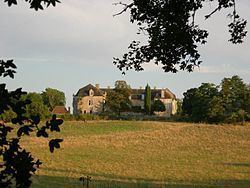 | ||
La Pannonie is an old village of the Lot region, between Gramat and Rocamadour, situated since the 19th century in the commune of Couzou. Now, the village is near an old castle built in the 15th century and transformed during the 18th and 19th century.
Contents
- Map of La Pannonie 46500 Couzou France
- Toponymy
- Why La Pannonie
- Geography
- History
- Well known figures
- References
Map of La Pannonie, 46500 Couzou, France
Toponymy
The "Pannonie" name caused many papers and articles about the curious homonym form with the Hungarian Pannonia. In fact, near Rocamadour, the cistercian monks of Obazine (Aubazine Abbey) created the first farm named like that. In order to be present near the famous medieval city of pilgrimage, these monks received fields and villages by donations and sellings. Realizing a new organisation, sometimes they preferred to use new names for their foundations.
The La Pannonie cistercian farm was built during the 13th century, near the ruined village of Saint-Circ (or Saint-Cyr d'Alzou).
Why "La Pannonie"?
Geography
In the Gramat limestone area, near the wild and spectacular Alzou (Ouysse) Valley, La Pannonie is a little village between Gramat and Rocamadour. Situated in the Naturel Regional Park of the Causses of Quercy, this country is also referenced by the Natura 2000 network. Fields or forest of La Pannonie are usually closed by stone low walls. This tradition is ancient as a specific art. Each year, people found stones in fields and built new low walls. After this common task, it was easier to plough, and to keep sheep inside closed areas.
History
Around the end of the 12th century, the Saint-Cyr oppidum was attacked by bands of bandits, forcing the lord and his family to flee from. Historians thought about the passage of Henry Curtmantle, gone here in 1183. This son of Henry II Plantagenet, king of England, looted Rocamadour before dying in Martel. This Saint-Cyr family (or Saint-Circ) could find protection in their suzerain's Castle, lord of Thégra. The youngest son of Saint-Cyr, named Uc (or Hugh), was born in that place. During his life, he became a very famous "troubadour" (medieval artist) in South of France, North of Italy, Portugal and Spain.
During the 13th century, the Obazine Abbey (Aubazine) modified her network all around Rocamadour. After her farms in the Alix, in Calès, in Couzou, in Carlucet, near Seniergues, in Bonnecoste, cistercian monks built their last foundation in La Pannonie.
The area of Gramat was depopulated in the 14th century. Bad harvests caused famines, and famines didn't stop epidemics like the Black Death. During that period, the Dordogne River was a frontier with English Aquitaine, and pillages by marauding mercenary armies were a frequent risk for people.
After war, the Obazine Abbey preferred rent out its fields and farms. Most of them were chosen by rich families, building there "repaires", sort of little fortified castle. Traders living in the Caretta castle, in the city of Rocamadour, made the first castle of La Pannonie. Their name was "Lagrange", and the construction was made between the end of the 15th century and the first beginning of the 16th century. The de Lagrange kept their domain until the 17th century.
La Pannonie was bought in 1685, and the Vidal de Lapize transformed their manor to a charming palace. This construction was the most important of the 18th century in the Lot department. Plans, drawings coming from Paris inspired the classic architecture with a central pediment, and Louis XV style furniture, and gypsum sculptures with Rococo style.
Very happy in their peaceful castle of La Pannonie, the Vidal de Lapize suffered the French revolutionary period because of the emigration of Antoine and his sons. So farmers protected goods and castle, and they hid the youngest son Louis-Antoine as their own son. With their help, the two daughters could pay the castle, and they could live in their childhood that they loved.
At the end of the 19th century, Charles of La Pannonie, modified his castle and grounds, creating a new entrance and three ponds in a new English style grounds.
